Sorted by date Results 26 - 50 of 78
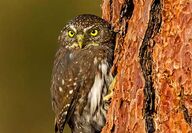
One of our smaller and most tenacious owls, the Northern Pygmy Owl [Glaucidium Gnoma], hunts during the day. Large insects, rodents, and songbirds make up the majority of their diet. Pygmies are found in habitat ranging from deciduous woods to high-elevation fir and spruce forests. Nesting in tree cavities, the Northern Pygmy Owl will lay two to seven white eggs and wait until all eggs are laid before beginning incubation. After fledging, the adults will continue feeding... Full story
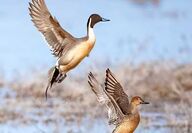
A relatively common dabbler duck, the Northern Pintail [Anus acuta], feeds on grains, seeds, crustaceans, and aquatic insects. It gets its name from the long tail feathers ending in a distinctive narrow sharp tip. They build their nest amongst the reeds in marshes and begin nesting in very early spring, laying six to 12 pale olive eggs, which hatch in 21-25 days. Ducklings leave the nest immediately, and are capable of flying in 38-45 days. Pintails once were one of the most... Full story
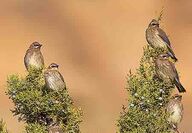
Berries and insects are being gleaned around Sisters right now - by Cedar Waxwings [bombycilla cedrorum]. They occur in medium to large flocks that will be seen on almost any tree that has berries. Serviceberry, dogwood, honeysuckle, juniper, and mistletoe are just a few fruiting plants that provide food. In winter, they consume cedar berries, hence their name. Waxwing refers to the red waxy secretions that appears on their secondary feathers, which may help in attracting a... Full story
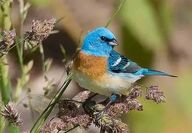
Lazuli Bunting (Passerina Amoena), which means beautiful sparrow, may be Oregon’s most colorful bird, brilliant blue with a cinnamon chest. Named for the gemstone Lapis Lazuli, this bunting is found commonly on the edges of forests in the Cascades. A seed and bug eater, the Lazuli Bunting inhabits scrubby brush areas that often contain patches of grass. When first-year males arrive on their breeding areas, they mimic the other males in order to learn a territorial song, often... Full story
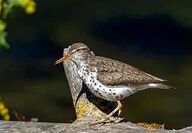
The most widely spread sandpiper in N. America is the Spotted Sandpiper [actitis macularius]. They live along rivers, lakes, and ponds, bobbing and teetering upon the shoreline to eat many bugs and crustaceans. They are often called a teeter-tail, tip-tail, or perk bird. Their chicks start to “teeter” as soon as they hatch. It is not known what function this serves. Spotted Sandpipers get their name from the dark spots that appear on their white breast during the breeding sea... Full story

The Pileated Woodpecker (dryocopus pileatus) is home in a mature forest with dead snags that become large drums for the majestic woody. Whether for proclaiming territory, communicating, or chipping out a nest, decaying trees are essential for a healthy population of the largest species of woodpecker in North America. With a body length of 15 to 19 inches and a 29-inch wingspan, they have a home territory of 320 to 600 acres. Both parents excavate the 10-to-24-inch-deep nest, w... Full story
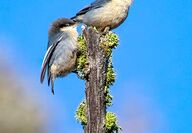
Walking through central Oregon’s ponderosa forests, the twittering and chirping one is most likely to hear is the Pygmy Nuthatch, feeding on insects while climbing all over the ponderosa and lodgepole pines. The Pygmy Nuthatch (Sitta pygmaea), chatters its high-pitch staccato call year-round, gleaning insects and seeds as it forages the entire tree from trunk to needles. This tiny bird, 3.75 to 4.5 inches, is monogamous, bonding year-round with its mate. Both male and f... Full story

When the Spotted Towhee [Piplio Maculatus] is seen, often on low branches or on the ground, its colors are a stunning contrast to all the surroundings. It is a common bird of the thickets and blackberry brambles, seen under bird feeders eating seeds off the ground but never far from cover. They feed mostly on insects, berries, and seeds scratched from leaf litter. In April the female builds the nest using soft grasses, twigs, and animal hair. While she finishes the nest, the... Full story

The American Dipper [Cinclus mexicanus] or Water Ouzel is found singing and bobbing on fast- moving streams throughout the western U.S. Searching for aquatic insects and small fish, the Dipper dives and sometimes swims under water while overturning rocks to find their food. They have white upper eyelids that protect their eyes and that also may help in blinking communication while on the loud rushing rivers. The female chooses a nest site that is above flood stage and then, wi... Full story

If you want a unique challenge, venture into the Cascades and attempt to find and listen to the brilliant Nashville Warbler [Leiothlypis ruficapilla]. Nashville Warblers are so called because the first one was discovered along the Cumberland River at Nashville, Tennessee, by Alexander Wilson in 1811, during this warbler’s migration. Although they do not nest in Tennessee, the name has remained. Nashville Warblers are one of the few warblers that nest on the ground, building a... Full story

Raucous, boisterous, annoying, disagreeable are just a few terms used to describe the Steller’s Jay (Cyanocitta stelleri). Granted, much of their behavior can be described as loutish, and appreciating these forest birds can be challenging, however the mixed blues of their feathers are nothing but stunning and observing their creative ways is intriguing. The Steller’s Jay is a master mimic; crying babies, red-tailed hawks, cats, dogs, and other birds are just a few calls hea... Full story

The Western Bluebirds (sialia mexicana) will soon be returning to Oregon after wintering in California and Mexico. Dropping from a perch to feed on ground insects or consuming many berries including poison oak, elderberry, and mistletoe, our Western Bluebirds will build their nests in tree cavities or birdhouses. As members of the thrush family the male will begin singing before dawn to mark his breeding territory. The female gathers fine grasses, needles, feathers, and... Full story

The Mountain Bluebird [Sialia currucoides] seeks out open areas with a mix of grasses, shrubs and trees, in mountainous areas up to 12,500 feet. Clearcuts, meadows, and sagebrush/juniper habitat provide large insect populations for the feeding of fledglings. They require tree cavities or nest boxes for brooding. The female chooses her mate by the quality of the nest cavity that the male offers. She builds the nest as the male Mountain Bluebird brings insects to her while she... Full story

Frequently seen in fall on lawns, roads, suet feeders, and trees, the Northern Flickers (Colaptes auratus) are large, black-spotted woodpeckers with a sparkling red slash [male] on their faces, that feed mainly on ants and beetles. They are gathering now in loose groups of 5-10 birds and can be identified by a white tail as they fly away. Raucous sounds are heard in the forest as flickers play while circling around the trunks of trees. The Northern Flicker occurs in either... Full story

The American Goldfinch (Carduelis tristis) are gathering in fields and farms and bird feeders, as thistles and grasses are reaching maturity. The bright warbles and twitters are heard as they feed or fly overhead. This small finch eats only seeds and waits til June and July to nest because the harvest of seeds will feed their nestlings in August and September. They complete a yearly second feather molt which is unique within their species. The female builds the nest with... Full story

Gliding up- and downstream on the Metolius or Deschutes rivers, the American Osprey (Pandion haliaetus) searches for available fish, which is 99 percent of its diet. When its prey is spotted, the Osprey dives in the water and uses the barbed pads on the bottom of its talons to grip the slippery fish, and carries it headfirst to make it as aerodynamic as possible. An outer toe is reversible to enable it to grasp the fish with two toes forward and two back, which provides a... Full story
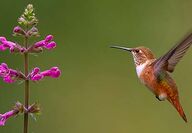
Rufous Hummingbird (Selasphorus Rufus) is a fiery and often quarrelsome hummingbird that is the most common visitor to our nectar feeders. The brilliant orange gorget and rufous back flash in the sunlight as they move from blossom to blossom gleaning nectar. The Rufous is an important pollinator within the plant communities, pollinating a number of plants that bees are unable to reach. Weighing in at a little over a penny, the Rufous Hummingbird feeds frequently, for it can... Full story

The red-naped sapsucker [Sphyrapicus nuchalis] feeds on the sap and insects drawn to the sap after drilling small holes in mostly deciduous trees: birch, willow, and especially aspen. Hummingbirds may follow these sapsuckers and feed by actually sipping on the sweet sap. Nests are excavated within diseased trees and three to seven white eggs are laid directly on the nest bottom, resting on wood chips with no soft nesting material used. Both parents incubate the eggs for 10-13... Full story

The white-crowned sparrow in the accompanying photograph is busy building a nest in the middle of Oregon grape leaves here in my yard in Camp Sherman. The females choose the nest site and handle the nest construction. As spring begins, the bulky five-inch nest is constructed on the ground with grasses, twigs, hairs and feathers. Three to seven pale blue or green-black spotted eggs are laid and hatched in 11 to 15 days. In ten days the nestlings are feeding on their own. Their... Full story
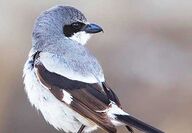
The northern shrike (Lanius borealis) is a predatory songbird, who perches quietly, often in the top of a tree, before swooping down after insects, mice, and small birds. It kills more than it can eat, impaling the prey on a thorn or wedging it in a forked twig. Like other northern birds that depend on rodent populations, the northern shrike’s movements are cyclical, becoming more abundant when northern rodent populations are low. They hunt from an open perch, where they s... Full story
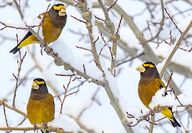
Evening grosbeaks (Coccothraustes vespertinus) are returning to Central Oregon now in search of seeds and possible nesting sights. They were erroneously named by Midwest settlers in the 1800s, because they thought the birds only came out in the evening to sing. Nomadic by nature, the French Americans named them wandering grosbeaks. They travel in flocks, gracing the air with clear ringing chirps, descending to treetops or bird feeders to enjoy seeds and nuts or tree buds. The... Full story

Northern flickers (Colaptes auratus) are large, black-spotted woodpeckers that feed mainly on ants and beetles. They are often seen on lawns and sidewalks gleaning insects and may be seen in loose groups of five to 10 in late summer and fall. The northern flicker occurs in either red-shafted- west of the Rocky Mountains, or yellow-shafted in the eastern U.S., and will hybridize to yield various shaft color and head pattern combinations. Gaffer, hairy-wicket, heigh-ho, gawker,... Full story
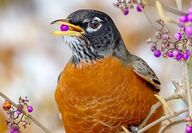
In early spring the symphonious melodies of the male American robin [Turdus Migratorius] are heard over the entire U.S. They begin mating in April and can produce up to three broods by the end of July. The female builds the cup-shaped nest with grass, twigs, and feathers and a coating of mud for stability. Occasionally the male will assist in the gathering of materials. The nest is built in many places including drainpipes, in wreaths on doors, window ledges, and, of course,... Full story

Williamson’s Sapsuckers (Sphyrapicus thyroideus) are generally found in the mountains of the western U.S. where they prefer forests of older coniferous trees. Sapsuckers are a specialized group of woodpeckers that do not actually suck sap. After pecking neat rows in trees to cause sugary sap to flow, sappys lick it up with tongues tipped with stiff hairs. This also brings insects, which are gleaned by hummingbirds and warblers. The radically different plumages between the male... Full story

Ah the common Song Sparrow, (Melospiza melodia) — our winter companion, chirping their way through cold soggy weather. Unnoticed by many, loved by a few, the Song Sparrow is a bright light if you are enjoying the small things. It sings from a high perch to claim territory and flicks its tail to the sparrow rhythm, as it tells a story of weeds and grasses and seeds. Look closely, they possess ornamental patterns of russet and gray and white stripes. Songs enable the... Full story